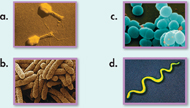20 Assessment
20.1 Viruses
Understand Key Concepts
Particles made up of proteins, nucleic acids, and sometimes lipids that can reproduce only by infecting living cells are called
bacteria.
capsids.
prophages.
viruses.
The structure labeled “A” in the diagram of the virus below is called the
viral genome.
RNA envelope.
capsid.
nuclear membrane.

One group of viruses that contain RNA as their genetic information is the
bacteriophages.
retroviruses.
capsids.
prophages.
What characteristics do all viruses have in common?
How are capsid proteins important to the way a virus functions?
Describe the sequence of events that occurs during a lytic infection.
Explain what a prophage is.
Think Critically
Compare and Contrast In terms of their mechanism of infection, how does a cold virus differ from the HIV virus?
Predict Explain how a mutation in a bacterial cell could help it become resistant to infection by a bacteriophage.
Apply Concepts Explain how a virus can spread in a bacterial population during the lysogenic phase of infection.
20.2 Prokaryotes
Understand Key Concepts
Prokaryotes are unlike all other organisms in that their cells
lack nuclei.
have organelles.
have cell walls.
lack nucleic acids.
Prokaryotes that thrive in oxygen-free environments are called
aerobes.
retroviruses.
anaerobes.
heterotrophs.
Which micrograph shows bacillus bacteria?

Prokaryotes reproduce asexually by
binary fission.
endospores.
conjugation.
mutation.
The process of converting nitrogen into a form plants can use is known as nitrogen
formation.
ammonification.
decomposition.
fixation.
What are the two distinguishing characteristics of prokaryotes?
Describe the three main cell shapes of prokaryotes.
Describe two methods by which prokaryotes move.
Think Critically
Predict Suppose certain bacteria lost the ability to fix nitrogen. How would this affect other organisms in their ecosystem?
Apply Concepts Why don't foods such as uncooked rice and raisins spoil?
Table of Contents
- Formulas and Equations
- Applying Formulas and Equations
- Mean, Median, and Mode
- Estimation
- Using Measurements in Calculations
- Effects of Measurement Errors
- Accuracy
- Precision
- Comparing Accuracy and Precision
- Significant Figures
- Calculating With Significant Figures
- Scientific Notation
- Calculating With Scientific Notation
- Dimensional Analysis
- Applying Dimensional Analysis




